- Shop
New to UCAN?
- About
- How to use ?
- Learn
- Contact us
The Ultimate Guide to Nitric Oxide Supplements for Aussie Endurance Athletes
By Generation UCAN. Last updated: 14 May 2024
Ever hit that wall in the final few k’s of a race, where your legs feel like lead and your pace just evaporates? Sound familiar? That frustrating fade might have less to do with your training and more to do with what’s happening inside your blood vessels. This is where nitric oxide supplements can come into play.
Think of nitric oxide (NO) as a tiny, powerful molecule that acts like a traffic controller for your circulatory system. Its main job is to tell your blood vessels to relax and widen—a process called vasodilation—which dramatically improves blood flow, oxygen delivery, and nutrient transport to your hard-working muscles. For any endurance athlete, this is a total game-changer, especially during those brutal February training blocks. It helps you get the most from your engine.
Contents
- 1 Why Nitric Oxide Matters for Your Performance
- 2 Two Key Pathways for Boosting Nitric Oxide
- 3 Beetroot Juice for Enhancing Endurance
- 4 L-Citrulline for High-Intensity Performance
- 5 The Critical Mistake That Wipes Out Your Nitric Oxide Gains
- 6 How to Build Your Nitric Oxide Supplement Plan
- 7 FAQ on Nitric Oxide Supplements
- 8 References
Why Nitric Oxide Matters for Your Performance
Let’s use an analogy. Imagine your blood vessels are a series of highways. During a tough training block or on race day, those highways can get seriously congested, creating a bottleneck that stops fuel and oxygen from getting where they need to go.
Nitric oxide is the secret weapon that opens up extra lanes on those highways. This process is called vasodilation, and for any endurance athlete, it’s a huge deal.
When your muscles get more oxygen and fuel, your performance naturally gets a boost. This isn’t just theory; it’s the physiological advantage that helps you hold your pace in the final stretch of the Melbourne Marathon or power up a brutal climb during Ironman Cairns.
For Aussie athletes, this is especially crucial. Better blood flow also helps your body manage its core temperature – a critical factor when you’re battling the Brisbane humidity or training through a scorching summer. It’s all about making your body more efficient under stress.
The Real-World Benefits
So, what does all this vasodilation actually feel like in practice? When you successfully boost your NO levels, you can expect to notice a few things:
- Improved Endurance: Your muscles get a steadier supply of oxygen, allowing you to sustain a higher intensity for much longer.
- Reduced Fatigue: Better circulation is key to clearing out metabolic waste products like lactate, which helps delay that all-too-familiar heavy-legged feeling.
- Enhanced Recovery: Flooding your damaged muscle tissue with more nutrients post-workout can genuinely speed up the repair and recovery process.
And this isn’t just a concern for the pros. With around 67% of adult Aussies now meeting physical activity guidelines, the interest in supplements that support muscle oxygenation is definitely on the rise. You can learn more about the market for nitric oxide supplements to see just how popular they’ve become.
In this guide, we’re going to break down exactly how you can use specific supplements like beetroot juice and L-citrulline to naturally increase your nitric oxide levels. We’ll skip the dense science lecture—you can find more on that in our deep dive into UCAN’s nutrition science—and focus on giving you practical, coach-like advice you can use to get a real performance edge. It’s not just about popping a pill; it’s about understanding what to take, when to take it, and how to avoid the common pitfalls that can sabotage your hard-earned gains.
Two Key Pathways for Boosting Nitric Oxide
So, how do nitric oxide supplements actually work? To put it simply, imagine you have two different motorways leading to the same destination. Both get you where you need to go—more nitric oxide—but they take completely different routes and are suited for different kinds of journeys.
Getting your head around these two pathways is a game-changer. It’s the difference between just guessing with a supplement and strategically choosing the right one to hit a specific training goal.
The Beetroot Route: The Nitrate-Nitrite-NO Pathway
This is the pathway that’s made beetroot juice famous in endurance circles. It’s a fascinating biological process that hinges on something you might not expect: the friendly bacteria living in your mouth.
Here’s a quick rundown of how it unfolds:
- You start by consuming dietary nitrates, most commonly from beetroot juice or leafy greens like rocket and spinach.
- Specialised bacteria on the back of your tongue get to work, converting these nitrates into nitrite.
- Once you swallow, this nitrite enters the acidic environment of your stomach, where it’s converted into nitric oxide. From there, the NO is absorbed into your bloodstream to work its magic.[3]
The most surprising part? It all kicks off on your tongue. This is a slower, more sustained method for raising NO levels, which is exactly why it’s so brilliant for long-haul endurance events. Research points to chronic supplementation—think daily doses for about a week—as the sweet spot for unlocking real benefits, like improving your running economy by making your body more efficient with oxygen.[1]
This is where improved blood flow becomes a cornerstone of endurance performance, as the image below illustrates.
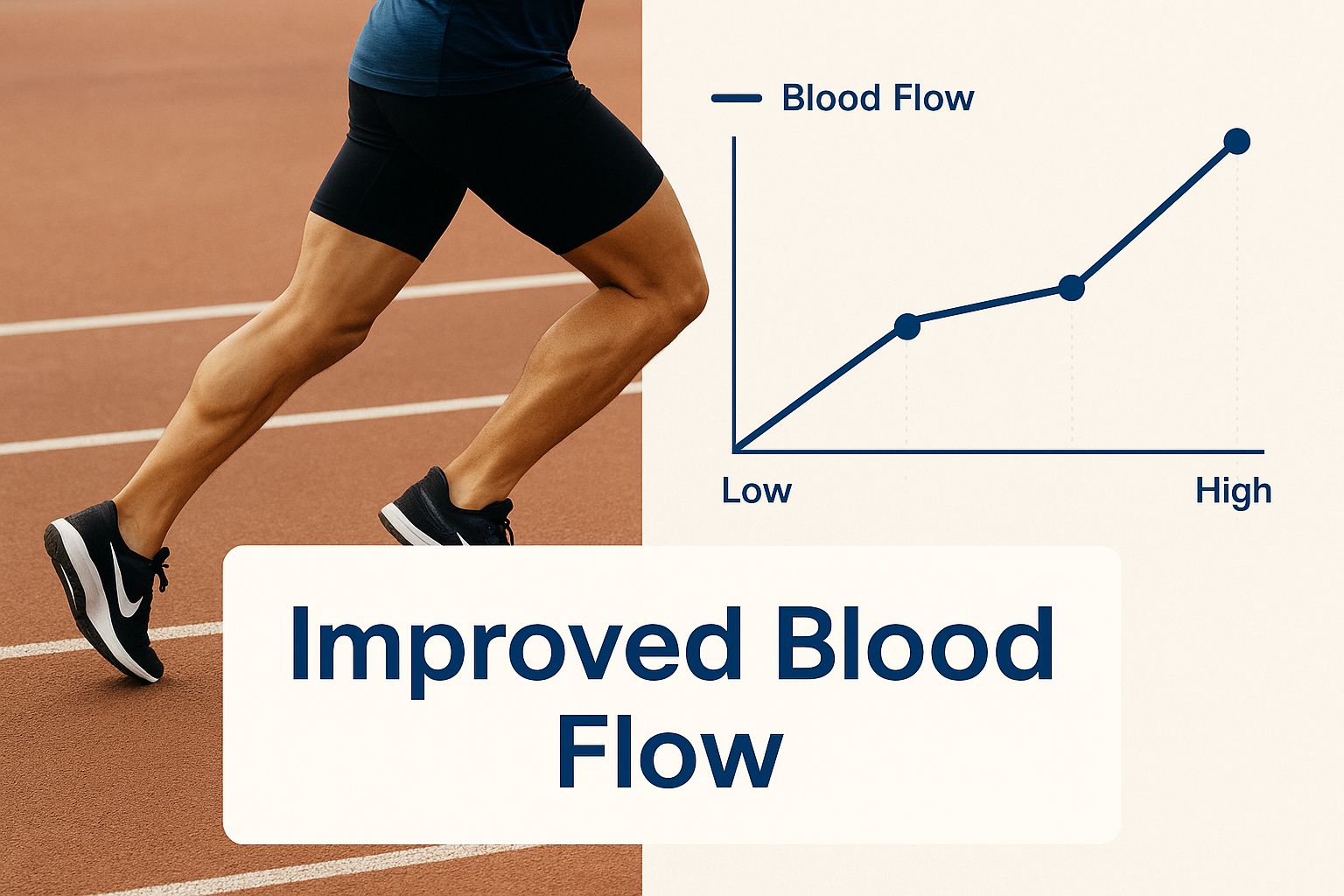
ALT text: A diagram illustrating the benefits of increased blood flow for athletic performance, showing oxygen and nutrients reaching the muscles more efficiently.
As you can see, boosting blood flow isn’t just a minor tweak; it’s a fundamental upgrade to your body’s entire engine.
The L-Citrulline Route: The L-Arginine-NO Synthase Pathway
Now for the second motorway. This pathway is much more direct and doesn’t involve your oral microbiome at all. Instead, it uses an amino acid called L-arginine and an enzyme in your body known as nitric oxide synthase (eNOS) to produce nitric oxide directly inside your blood vessels.
You might be wondering, “Why not just supplement with L-arginine then?” It’s a fair question. The issue is that L-arginine gets heavily broken down by your gut and liver before it even has a chance to do its job, making it a pretty inefficient option.
This is where L-citrulline shines. L-citrulline, another amino acid, offers a clever workaround. It bypasses this initial breakdown, gets absorbed easily into your bloodstream, and travels to your kidneys, where it’s then converted directly into L-arginine. The result is higher and more sustained blood arginine levels than you could ever get from taking L-arginine itself.
The key takeaway: L-citrulline is simply a more effective way to raise L-arginine levels in your body, which leads to a more powerful and reliable nitric oxide boost.
This pathway is much faster-acting, making it the perfect choice for high-intensity efforts. We’re talking about track intervals, a sharp climb in a cycling race, or pushing the pace in a 10K. Research on cyclists has shown that taking L-citrulline about an hour before a time trial can measurably improve performance.[2] It also helps your body clear out metabolic waste like ammonia, a major contributor to muscle fatigue.
So, you’ve got two different tools for two very different jobs: one for building sustained endurance and efficiency, and another for a direct power-up when you need it for those hard, sharp efforts.
Two Roads to More Nitric Oxide
To make it even clearer, let’s break down the key differences between these two pathways. Think of this as your cheat sheet for choosing the right approach based on your athletic goals.
| Pathway Feature | Nitrate-to-Nitrite Pathway | L-Arginine/L-Citrulline Pathway | |||
|---|---|---|---|---|---|
| Supplement Source | Beetroot juice, leafy greens (rocket, spinach) | L-Citrulline, L-Arginine (less effective) | |||
| Mechanism | Bacteria on the tongue convert nitrate to nitrite; stomach acid converts nitrite to NO. | L-Citrulline converts to L-Arginine in the kidneys, which directly produces NO in blood vessels via the eNOS enzyme. | |||
| Speed of Action | Slower, builds up over days. | Faster, effects felt within an hour or so. | |||
| Best For | Sustained endurance, improving oxygen economy (e.g., marathons, long-distance cycling). | High-intensity efforts, reducing fatigue (e.g., intervals, sprints, time trials). |
Ultimately, knowing which pathway to target allows you to be much more precise with your supplementation strategy, matching the right ingredient to the specific demands of your training and racing.
Beetroot Juice for Enhancing Endurance
Alright, let’s talk about the purple stuff. If you’ve spent any time in endurance circles, you’ve no doubt heard the buzz around beetroot juice. It’s one of the most well-researched nitric oxide supplements out there, and for bloody good reason—it actually works.
But here’s the mistake I see countless athletes make: they treat it like a last-minute magic bullet. Downing a shot an hour before your race start isn’t going to cut it. The real power of beetroot juice is unlocked through consistency. This isn’t a one-and-done deal; it’s all about the loading strategy.
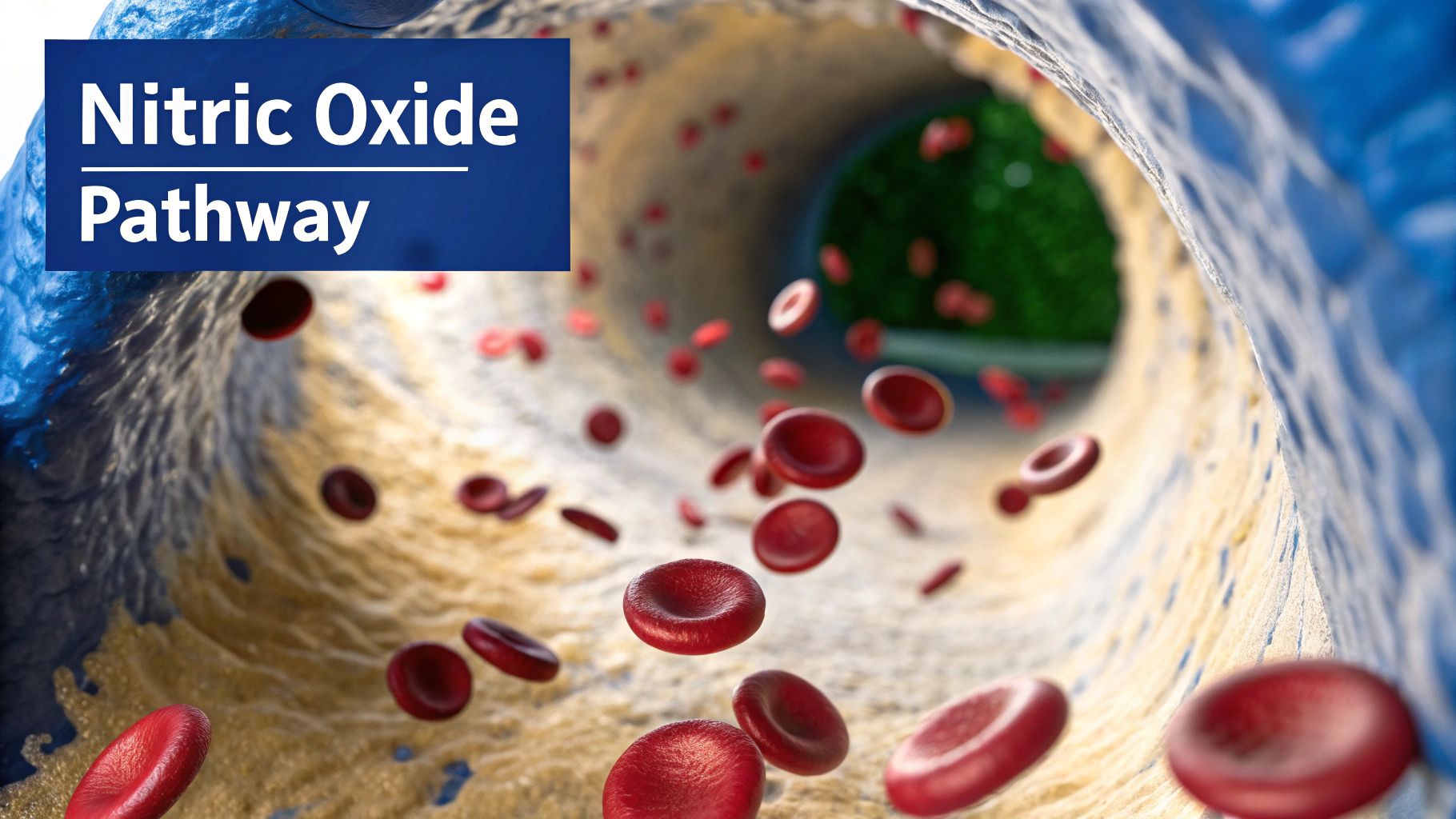
ALT text: A glass of vibrant beetroot juice next to fresh beetroots, illustrating a natural source of nitric oxide supplements.
Why Consistent Loading Is Non-Negotiable
So, why the big focus on loading up for a week? It all comes down to improving your running economy. Better running economy means your body becomes more efficient. You use less oxygen to hold a specific pace, whether you’re on the bike or pounding the pavement.
Think of it like getting your car’s engine tuned for better fuel efficiency. Suddenly, you can go further and faster on the same tank of petrol. The science on this is solid. Peer-reviewed studies show that acute supplementation with beetroot juice for just five days can reduce your oxygen consumption by as much as 3% at a solid aerobic intensity (around 70% of your VO₂ max) in trained athletes.[4]
That 3% might not sound like a game-changer, but over the course of a marathon or a 70.3 triathlon, it’s absolutely massive. It can be the difference between holding your goal pace through the 35km mark or hitting the wall and watching your race plan crumble.
How to Apply It to Your Race Week
Let’s get practical. You’ve got a big race on the horizon, like the Gold Coast Marathon. Here’s your game plan for using beetroot juice to give yourself a real edge.
The Protocol: Start taking a concentrated beetroot juice shot (around 70-140ml, depending on the brand’s concentration) every single day for the 5 to 7 days leading into your race.
The timing during the day isn’t super critical, but I find it’s easiest to just make it a habit with breakfast so you don’t forget. This daily dose allows your body to build up and store the necessary nitrates, ensuring your system is primed and ready to produce nitric oxide when you need it most on race morning.
This strategy fits perfectly alongside your existing race week nutrition plan. It doesn’t replace anything; it enhances it. You’ll still be focusing on your carb-loading and finalising your race day fuelling strategy. In fact, combining a beetroot loading phase with your standard fuelling is a killer combination for peak performance.
If you’re looking for guidance on your broader nutrition plan, check out our guide on how to fuel your body during a marathon.
For those interested in growing their own natural sources of nitrates, you can even find Detroit Dark Red Beet Seeds to cultivate your own.
The bottom line is simple: think of beetroot juice as a week-long preparation tool, not a race-day quick fix. Get the loading phase right, and you’ll give yourself a genuine physiological advantage before you even step on the start line.
L-Citrulline for High-Intensity Performance
If beetroot juice is your best mate for the long, steady grind of a marathon, think of L-citrulline as your secret weapon for the sharp, painful efforts. We’re talking about those lung-busting intervals, the constant surges in a criterium race, or punching it up a steep climb. This is where L-citrulline truly shines.
You’ve probably seen L-arginine on supplement shelves and figured it’s the most direct route to boosting nitric oxide. But here’s the catch: your gut and liver give L-arginine a really hard time, breaking it down before it can get to work. L-citrulline is the smarter way to go.
It cleverly bypasses that initial breakdown, gets absorbed much more efficiently, and then converts into arginine inside your kidneys. The result is a much higher and more sustained level of arginine in your blood, leading to a far more reliable nitric oxide boost. It’s a brilliant biological workaround.
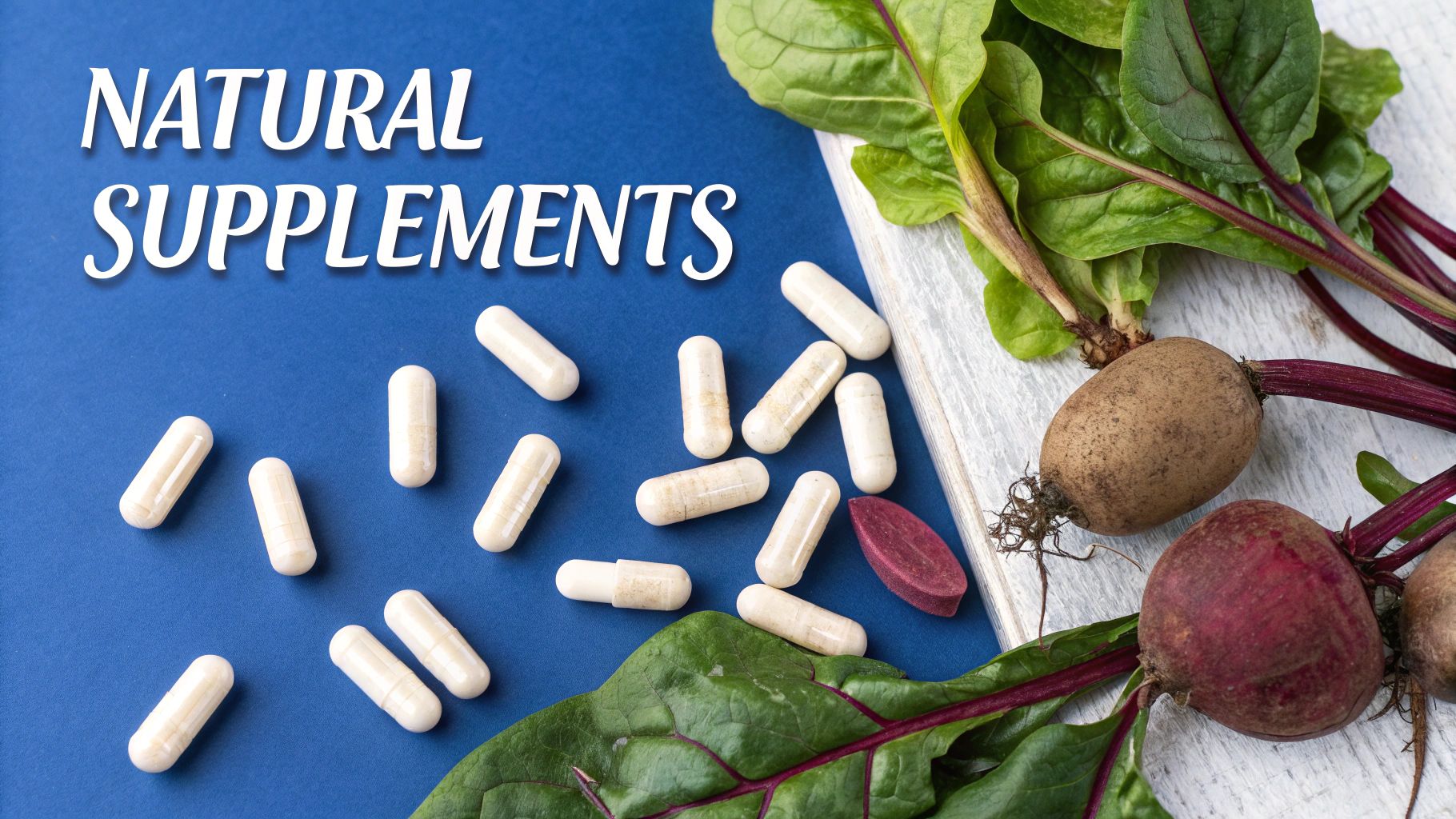
ALT text: A molecular structure of L-citrulline, highlighting its role in nitric oxide production for high-intensity exercise.
When and How to Use It
Unlike the slow-and-steady approach with beetroot juice, L-citrulline is all about acute timing for a specific performance boost. Its effects are much more immediate, making it perfect for those key high-intensity sessions you’ve got circled on the calendar.
The research gives us a pretty clear protocol for dosage and timing. To get the most from L-citrulline for sports performance, take 6,000–8,000 mg (that’s 6-8 grams) of citrulline malate about an hour before your session.[5] This gives your body plenty of time to absorb it and get those nitric oxide levels peaking just as you’re about to dig deep. One 2016 study found that trained cyclists who took 2.4g of L-citrulline per day for 7 days also improved their time trial performance, so there’s evidence for both acute and chronic use.[2]
The Real-World Application for Aussie Athletes
Let’s put this into practice. Imagine you have a brutal session on the schedule: 6 x 1km repeats at your 5km race pace. This is exactly the kind of workout where L-citrulline can make a real difference.
Here’s a simple way to structure your nutrition:
- 90 mins before: Have a light, easily digestible meal.
- 60 mins before: Mix your 6-8 gram dose of citrulline malate with water and drink it down.
- 30 mins before: Start sipping on a UCAN Energy drink or have an Edge gel. This ensures your blood sugar is stable and you’ve got steady energy on tap.
This combination is incredibly effective. The L-citrulline gets to work opening up your blood vessels and improving muscle efficiency, while the UCAN provides that unique, long-lasting fuel without the spike and crash you get from simple sugars. You’re hitting the workout from two crucial angles: better blood flow and rock-solid energy.
This isn’t just about feeling a bit better; it’s about getting more out of your hardest training days. Better blood flow means you can push harder for longer, recover a little quicker between reps, and ultimately nail your splits with more consistency.
Beyond the immediate performance kick, the cardiovascular benefits of L-citrulline can also contribute to your overall heart health and are among the strategies to lower your resting heart rate. It’s a powerful tool with benefits that extend well beyond a single workout. By adding L-citrulline into your routine for those specific, tough sessions, you aren’t just supplementing—you’re strategically sharpening your performance when it counts the most.
The Critical Mistake That Wipes Out Your Nitric Oxide Gains
Alright, let’s talk about something that drives me crazy. It’s one of those simple habits that can completely sabotage an athlete’s best efforts.
You can spend weeks perfecting your beetroot juice loading protocol, get your L-citrulline timing down to the minute, and feel primed to smash a new personal best. But one incredibly common daily habit can wipe out all that hard work, essentially flushing your investment in nitric oxide supplements straight down the drain.
I can’t stress this enough. The mistake is using antiseptic mouthwash.
I know, it sounds strange. But for any athlete using nitrate-based supplements like beetroot juice, the science here is crystal clear and non-negotiable.
Why Mouthwash Is Your Enemy
Remember how we talked about nitrates from beetroot converting into nitric oxide? Well, that whole chain reaction kicks off in your mouth. Specifically, it relies on a colony of good bacteria that live on the back of your tongue.
Think of these bacteria as the essential factory workers on the nitric oxide production line. They perform the very first, and most crucial, step.
When you swish with a harsh, antiseptic mouthwash, you’re not just killing off the germs that cause bad breath. You’re carpet-bombing your entire oral microbiome, taking out these critical workers in the process. You effectively shut down step one of the very system you’re trying to boost.[6]
It’s like trying to bake a cake but throwing out the flour before you even start. No matter what other ingredients you add, the recipe is doomed from the beginning.
The bottom line is this: using antiseptic mouthwash while loading with nitrates is like pedalling your bike with the brakes jammed on. You’re putting in the effort but completely killing your own forward momentum.
The Science Doesn’t Lie
This isn’t just a pet theory of mine; it’s backed by a heap of solid research.
Multiple studies have confirmed that wiping out these oral bacteria with mouthwash completely torpedoes nitric oxide production. This isn’t just an issue for performance, either. Longitudinal studies have even linked chronic mouthwash use with an increase in blood pressure and a higher risk for conditions like hypertension.[7] If you want to dive into the nitty-gritty, you can read more about the science behind oral bacteria and nitric oxide and see for yourself.
For an athlete, the takeaway is simple. If you’re investing your time and money into beetroot juice for that upcoming marathon or triathlon, using antiseptic mouthwash is the fastest way to guarantee you get zero return on that investment.
Your Action Plan
So, what’s the fix? Thankfully, it’s incredibly straightforward.
- Ditch the antiseptic mouthwash: At the very least, stop using it during your 5-7 day loading phase before a big event like the Sydney Marathon or Ironman Cairns.
- Check the label: Be on the lookout for ingredients like alcohol or chlorhexidine – these are the culprits designed to kill bacteria indiscriminately.
- Look for alternatives: If you absolutely can’t go without, find a natural, alcohol-free mouthwash that supports your oral microbiome instead of destroying it.
This is one of the easiest, yet most impactful, adjustments you can make. Don’t let a simple swish and spit undo all your hard work. Protect those friendly bacteria – your performance literally depends on them.
How to Build Your Nitric Oxide Supplement Plan
https://www.youtube.com/embed/G8LG0OY3Izs
Alright, let’s move past the theory and get practical. It’s one thing to understand what these supplements do, but knowing exactly how to weave them into your training week is where the real magic happens.
The market for nitric oxide supplements is absolutely flying, already worth around USD 1.1 billion globally. A huge part of that growth comes from Aussie athletes just like you, searching for that extra edge in performance and cardiovascular health. But simply buying a tub off the shelf isn’t a plan. If you want to dig deeper into this trend, you can read the full market analysis on giiresearch.com.
Let’s get down to the nitty-gritty. Here’s how you can structure your supplement timing around your specific training goals.
For the Big Endurance Event
Got a marathon, a long-course triathlon, or a massive Gran Fondo on the horizon? Your strategy should be all about the slow, steady build-up of nitrate loading.
- 7 Days Out: This is when you kick off your beetroot juice protocol. Start taking one concentrated shot (typically 70-140ml) every single day. Just make it a non-negotiable part of your morning routine.
- Race Morning: Down your final beetroot shot about 2-3 hours before the start, right alongside your usual pre-race breakfast. I’m a big advocate for pairing this with a serve of UCAN Energy + Protein to make sure your muscle glycogen is topped up and you’ve got amino acids ready to go.
For High-Intensity Sessions
What about those gut-busting track workouts or a hilly criterium race? This is where the faster-acting L-citrulline becomes your best mate. Think of it as your secret weapon for the sharp end of training.
- 60-90 Minutes Before Warm-up: This is your window to take L-citrulline malate. The sweet spot for most athletes is 6-8 grams. Just mix it with a small amount of water and get it down.
- 30 Minutes Before: Now it’s time for your UCAN. A UCAN Energy Gel at this point gives you that incredibly stable energy source to power you through the hard yards without the risk of a sugar crash.
Coach’s Tip: Never, ever try something new on race day. That’s the golden rule. Test these protocols during your key long runs and your toughest interval sessions. You need to know exactly how your body and gut will respond long before you’re standing on the start line.
At the end of the day, it’s not about picking one supplement over the other. It’s about building a performance toolkit and knowing precisely which tool to pull out for the job at hand.
FAQ on Nitric Oxide Supplements
Let’s dive into some of the questions I hear most often from athletes who are curious about nitric oxide supplements. My aim here is to give you the straight-up, practical answers you need to make smart decisions for your training and racing.
Can I Just Eat More Vegetables to Get Enough Nitrates?
In theory, yes. In practice, it’s incredibly tough. While leafy greens like rocket, spinach, and bok choy are nitrate powerhouses, the sheer volume you’d need to consume is the real problem.
To get the 300-600mg of nitrates shown to boost performance in studies, you’d be looking at a massive pile of greens. For most athletes, trying to stomach that much fibre right before a big event is a recipe for gut distress. This is exactly why concentrated beetroot juice shots have become a go-to solution—they provide a precise, convenient dose without the bulk.
What Are the Side Effects? Am I Going to Have Any Issues?
For most people, these supplements are very safe, provided you stick to the proven dosages. We’re talking about compounds derived from food, not some sketchy, stimulant-heavy pre-workout.
The most common (and startling, if you’re not expecting it!) side effect of beetroot juice is beeturia. It’s a harmless pink or reddish tint to your urine and stools. Don’t be alarmed; it’s just a sign your body has processed the beet pigments. L-citrulline is also known for being very easy on the system, though taking well above the 8-gram mark might cause some minor stomach upset for a few people. The golden rule? Always trial anything new in training.
How Quickly Will I Feel the Effects?
This is a great question, because the timing is completely different for the two main types of supplements. It’s not an instant-on switch.
L-citrulline acts relatively quickly. Its effects are acute, which means they build to a peak around 60 to 90 minutes after you take it. This makes it ideal for timing just before a key workout or the start of a race.
Beetroot juice is more of a long-term strategy. While you might get a small immediate benefit, the real magic happens with consistent loading. You need to take it daily for about 5-7 days leading into your event. This allows nitrate concentrations to build up in your body, properly priming your system for peak performance when it counts.
Is It Okay to Take Beetroot Juice and L-Citrulline Together?
Yes, you can, and for athletes targeting an A-race, it can be a really effective strategy.
They work their magic through two completely different biological pathways—beetroot relies on bacteria in your mouth, while L-citrulline is processed via the kidneys. This means they don’t get in each other’s way. A solid protocol could involve loading with beetroot for a week to build your endurance base, then adding a dose of L-citrulline about an hour before the gun goes off for an extra boost against fatigue.
But I can’t stress this enough: test that exact combination during a tough training session that mimics race intensity. Race day is never the time to experiment.
References
[1]] Jones, A. M. (2014). Dietary nitrate supplementation and exercise performance. Sports Medicine, 44(Suppl 1), 35–45.
[2] Suzuki, T., Morita, M., Kobayashi, Y., & Kamimura, A. (2016). Oral L-citrulline supplementation enhances cycling time trial performance in healthy trained men: Double-blind randomized placebo-controlled 2-way crossover study. Journal of the International Society of Sports Nutrition, 13(1).
[3] Nathan, Bryan & T., N. (2014). Nitric Oxide and Oral Health.
[4] Domínguez, R., Cuenca, E., Maté-Muñoz, J. L., García-Fernández, P., Serra-Paya, N., Estevan, M. C., Herreros, P. V., & Garnacho-Castaño, M. V. (2017). Effects of Beetroot Juice Supplementation on Cardiorespiratory Endurance in Athletes. A Systematic Review. Nutrients, 9(1), 43.
[5] Examine.com. (2022). Citrulline benefits, dosage, and side effects.
[6] Burleigh, M., Liddle, L., Monaghan, C., Muggeridge, D., Sculthorpe, N., & Easton, C. (2018). The oral microbiome, nitric oxide and exercise performance. ScienceDirect.
[7] Joshipura, K. J. (2022). Pathways linking oral bacteria, nitric oxide metabolism, and health. ScienceDirect.
At UCAN, our goal is to give you the tools and knowledge to fuel smarter, not just harder. Combining steady-release energy with a smart nitric oxide strategy can be a powerful way to unlock your full potential.

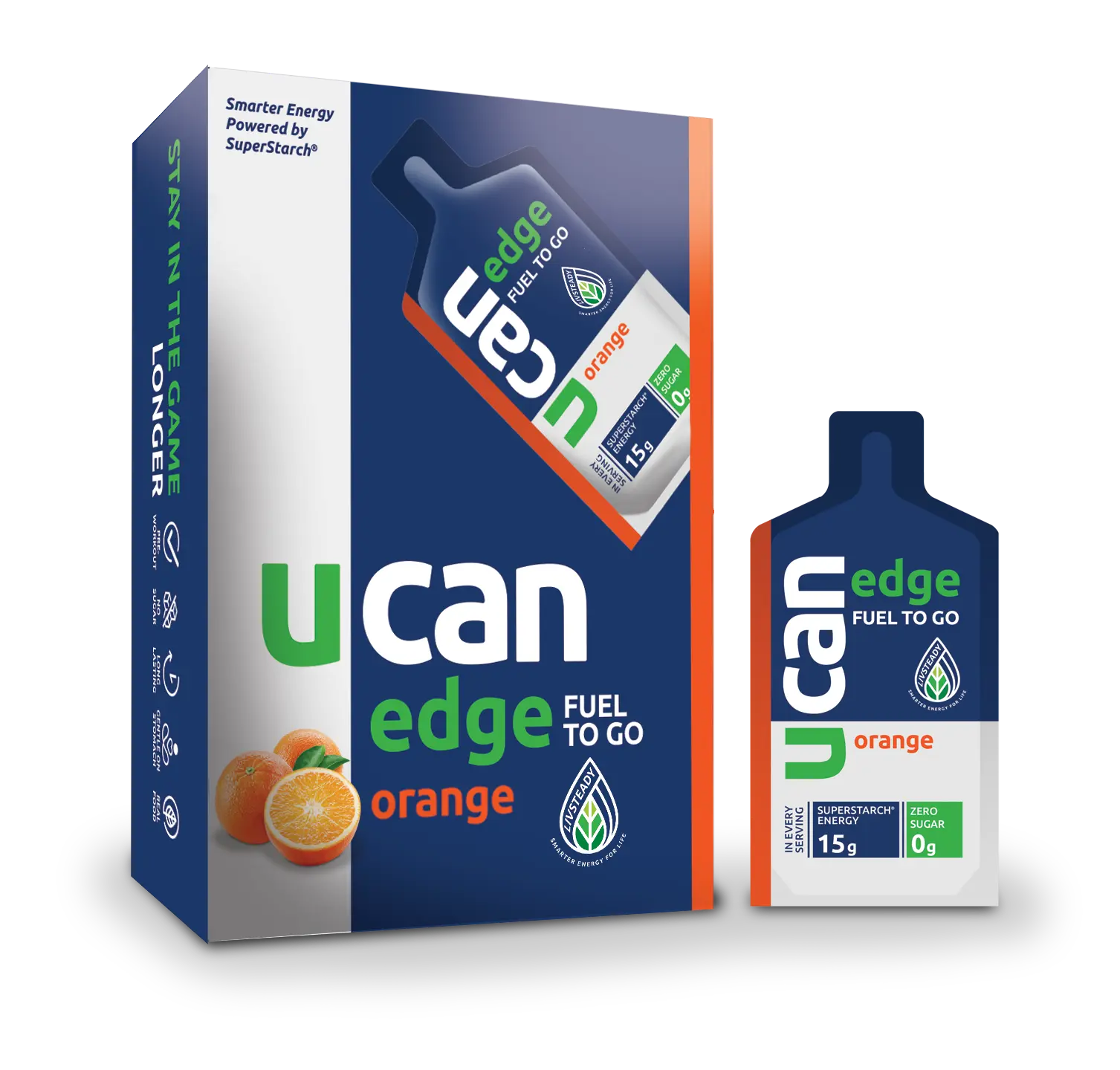
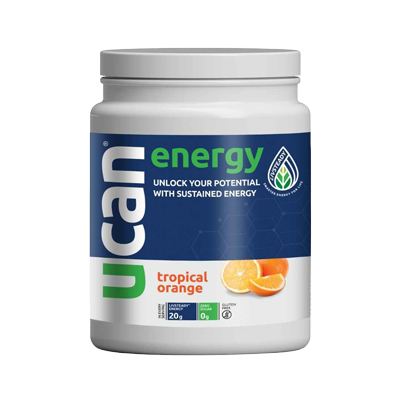
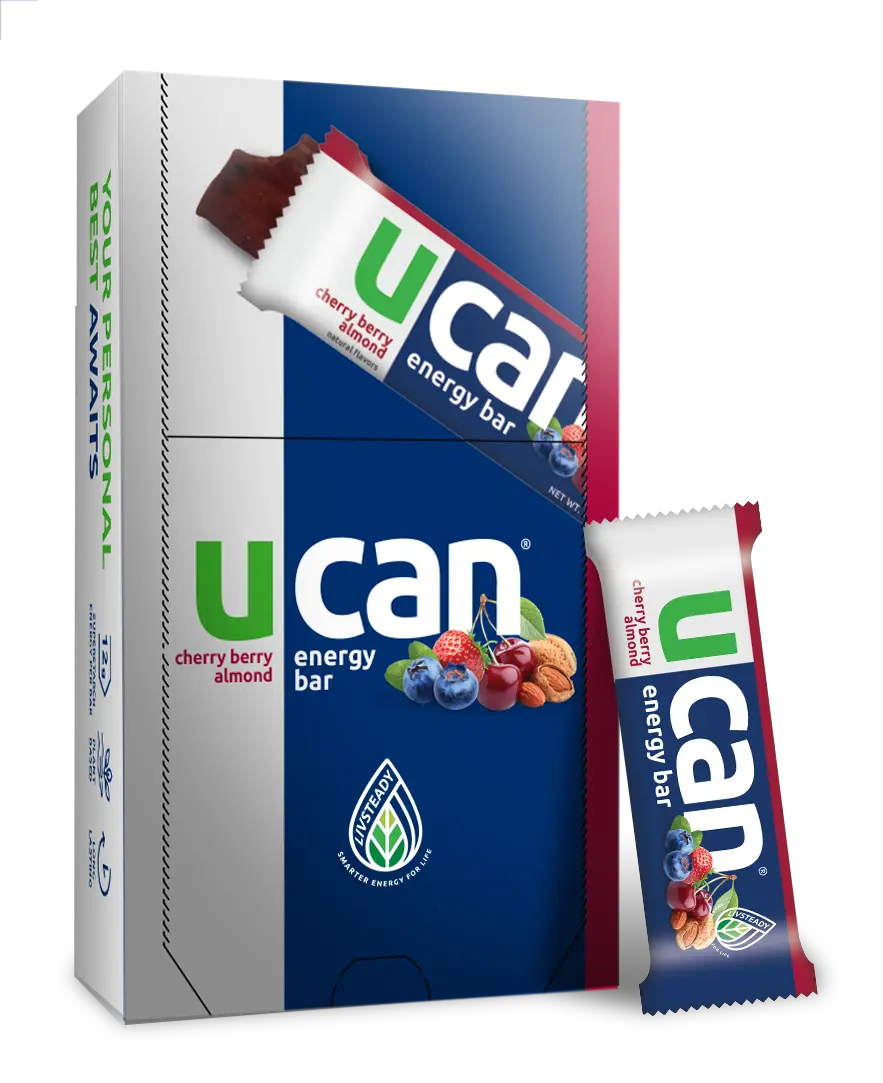
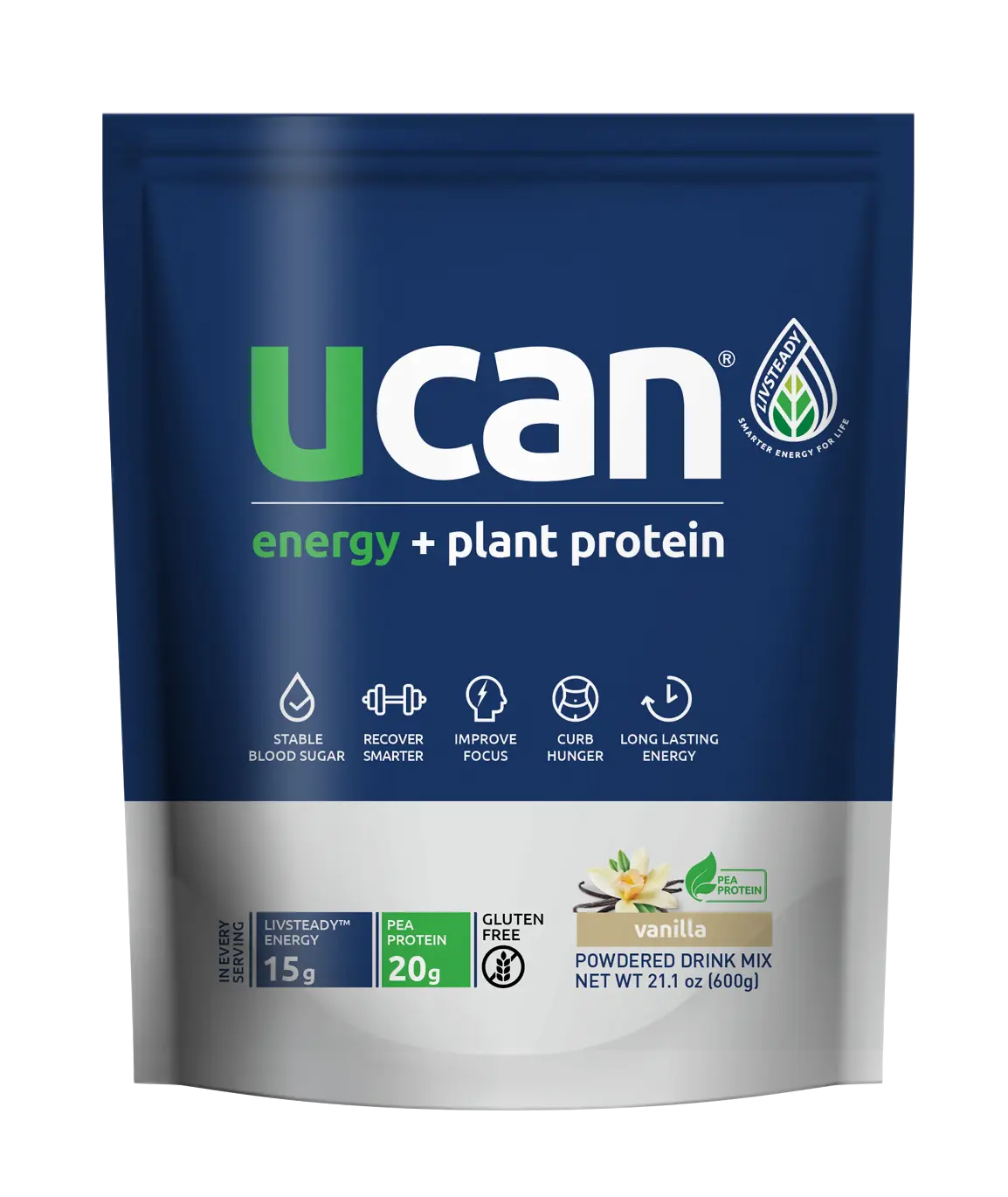
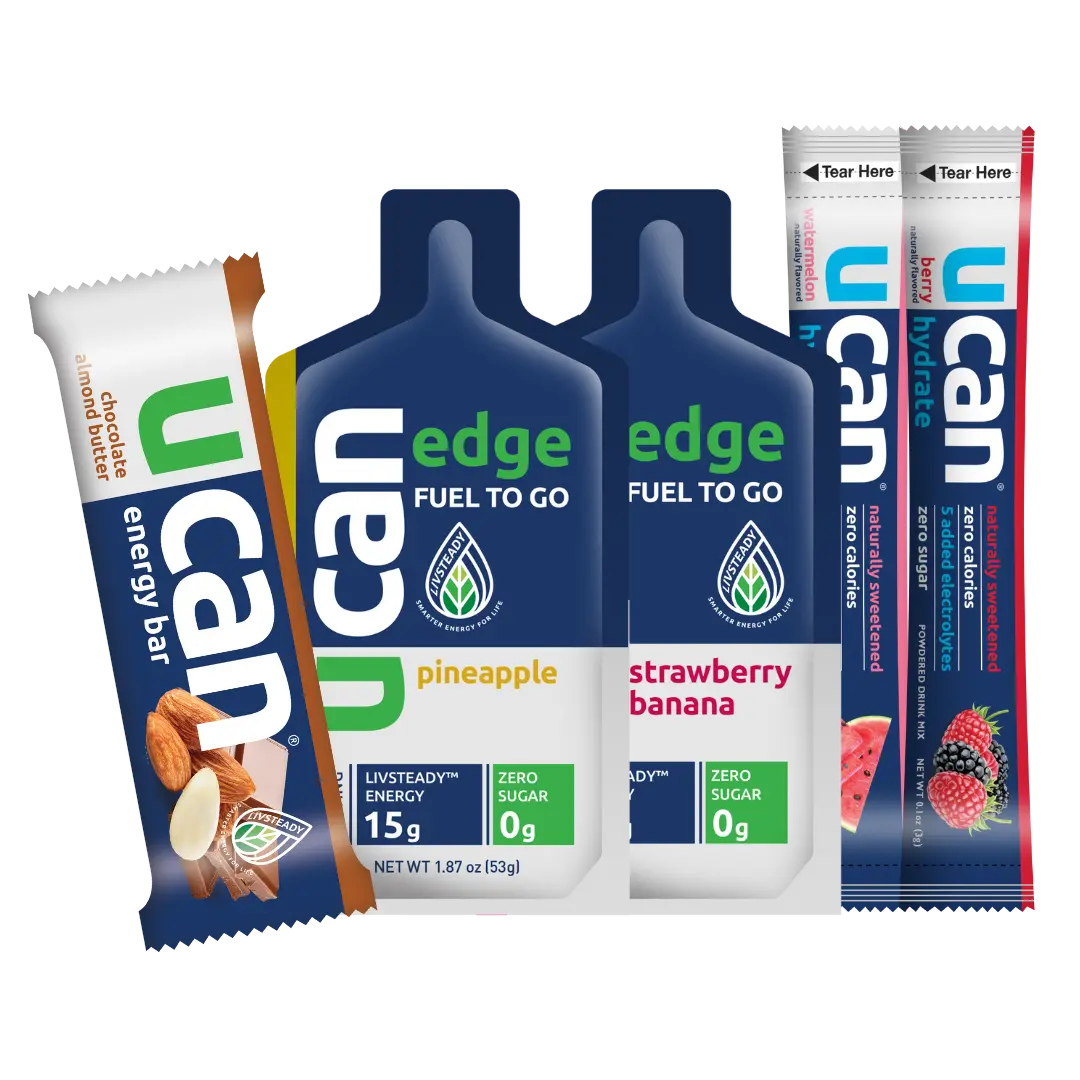
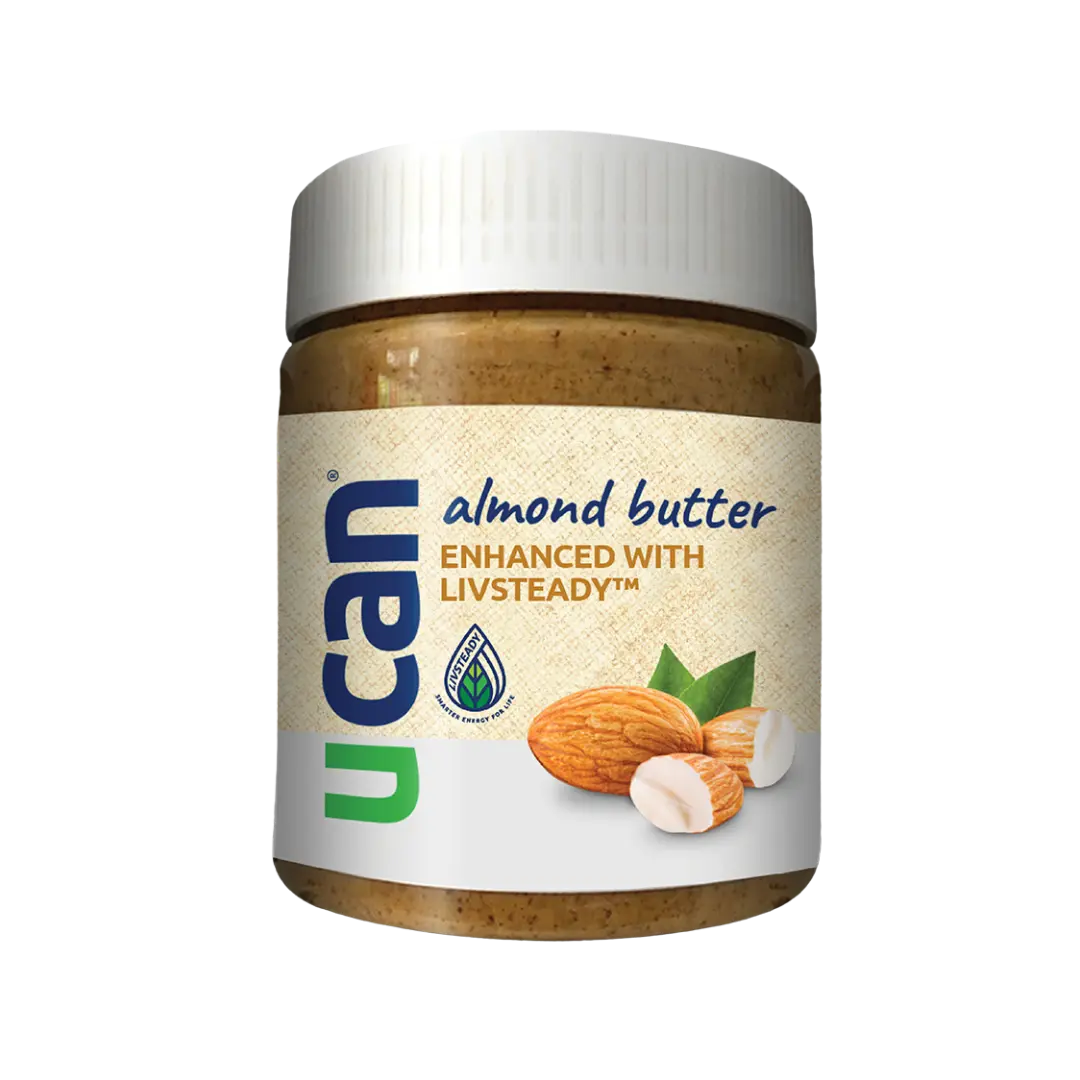
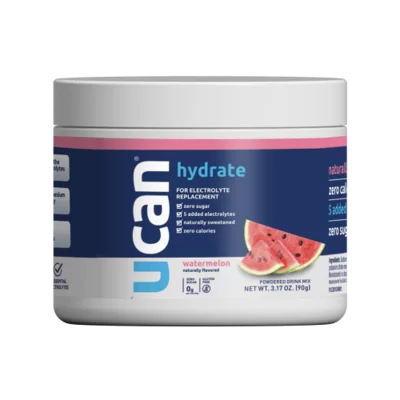
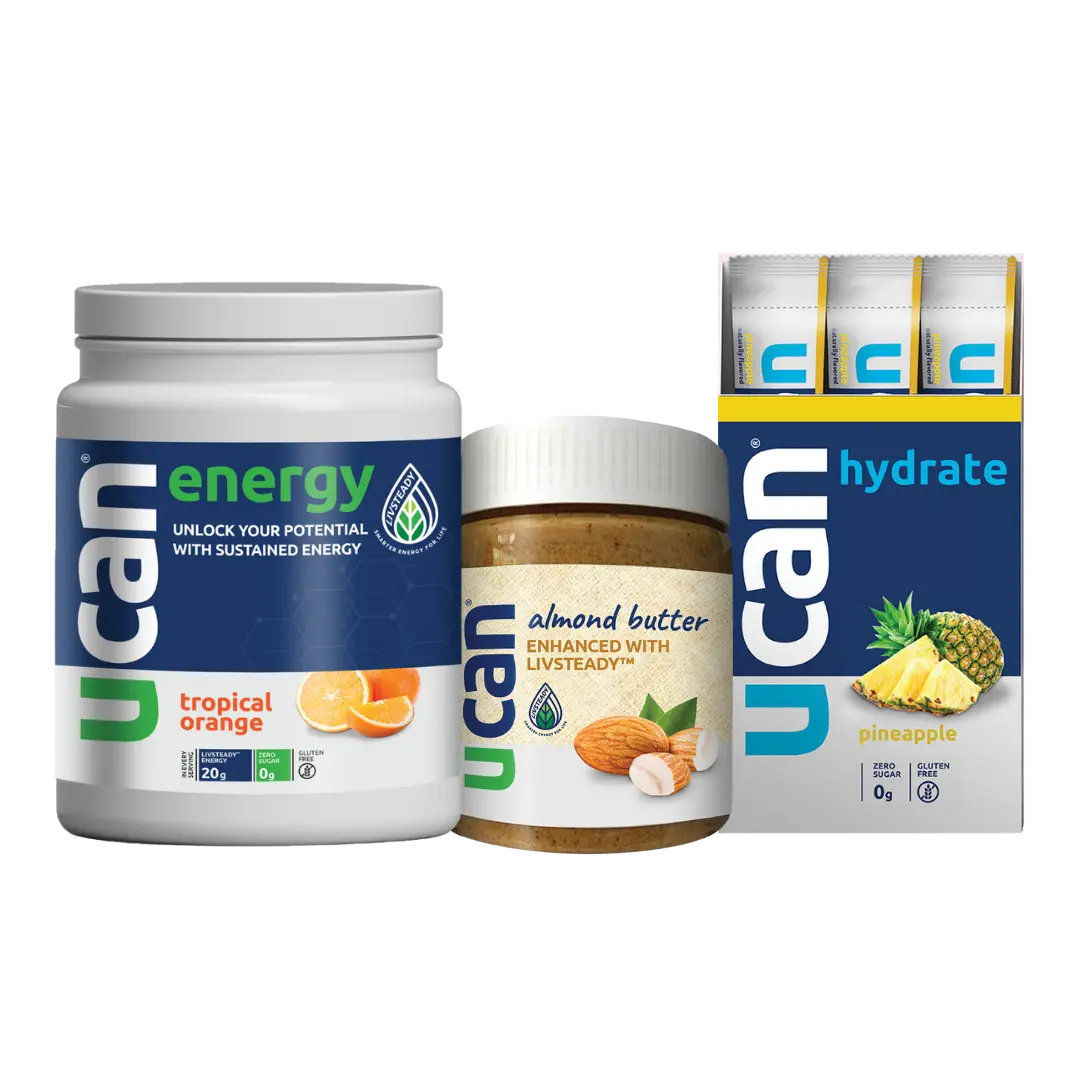
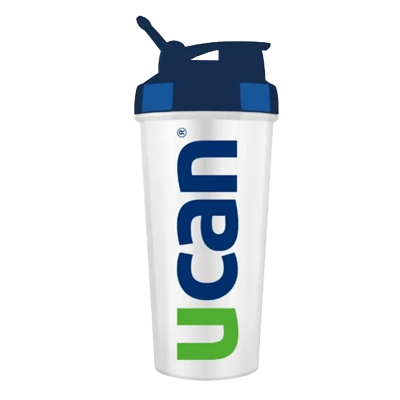
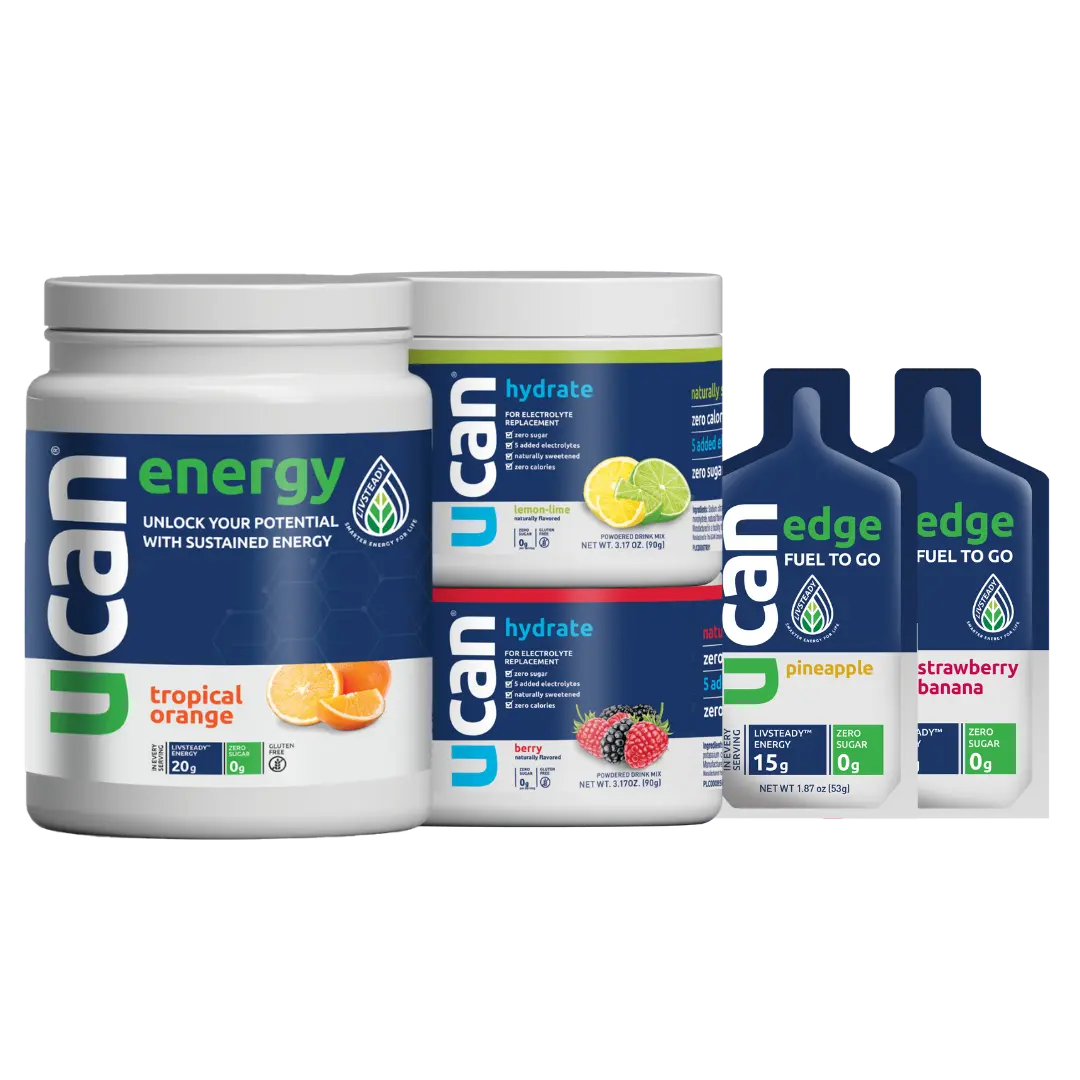
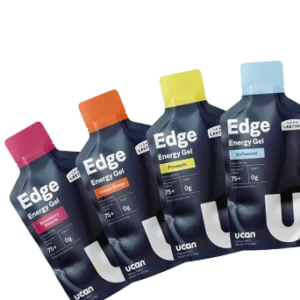
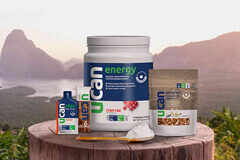


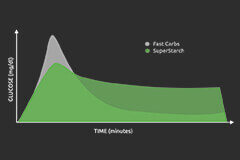

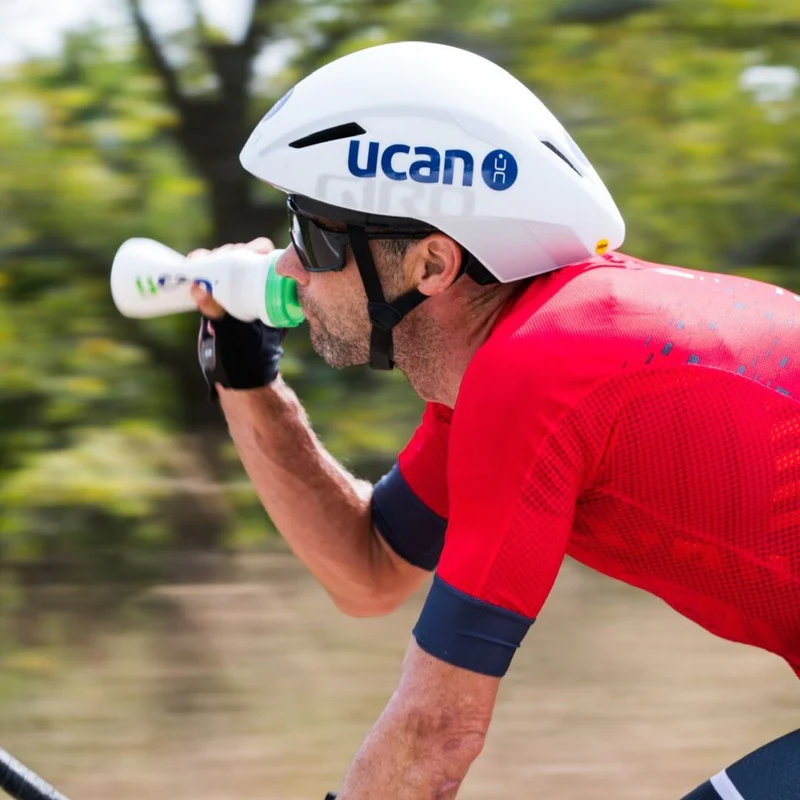


















Comments are closed